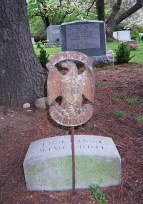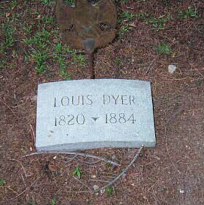Footsteps Through Time | Home
Louis C. Dyer | Mary Adeline Miner | Lemuel William Harrington | Susan Mingo | William Moran | Bridget Conway | Matthew Taylor and Elizabeth Barr | Hynds and Mingo Family
Louis C. Dyer

While the Dyers were in Johnsburg, New York, their first son was born to them on May 13, 1859. He was named William George Dyer. According to the 1880 Census, the Dyers had seven children, some born in Massachusetts, others in Canada. It is not clear if they had returned to Canada for a few years, until settling permanently in Massachusetts.
Lewis earned his living as a brick and stone mason in the Attleboro, MA area. He also kept a small farm.
Music filled the Dyer home. One of the Dyer sons became a music teacher, having learned the violin at his fatherís knee. No doubt, many lively French tunes were played often to entertain family and friends.
Lewis was also a member of the fraternal organization known as the Improved Order of the Redman, an offshoot of the Sons of Liberty, the famous group of patriots who threw English tea into Boston Harbor just as the cry for revolution echoed throughout the colonies.
Lewis and Mary did not share the same religion. Mary was a Catholic.
At the age of sixty-four, Louis died on Christmas Day in 1884. He is buried in Mount Hope Cemetery in North Attleboro, MA. An Improved Order of the Redman insignia marks his gravesite.


Louis Dyer was a member of this organization.
Improved Order of the Redmen
It's hardly accurate to describe the Soceity of Red Men as the first Native American order--they didn't admit Native Americans. But they were at least among the earliest American orders not imported from somewhere else.
Founded in 1835, the Improved Order of Red Men traces its origin to certain secret Patriotic Societies founded before the American Revolution. They were established to promote Liberty and to defy the tyranny of the English Crown. Among the early groups were: The Sons of Liberty, Sons of Tamina and the Society of Red Men.
On December 16, 1773 a group of men, all members of the
Sons of Liberty, met in Boston to protest the tax on tea imposed by England. When their protest went unheeded, they disguised themselves as Mohawk Indians, proceeded to Boston harbor and dumped overboard 342 chests of English tea.
During the Revolutionary War, members of secret societies
quenched their council fires and took up muskets to join with the Continental Army. To the cause of Freedom and Liberty, they pledged their lives, their fortunes and sacred honors. At the end of the hard fought war, the American Republic was born and was soon acknowledged among the Nations of the world.
Following the Revolution the various secret societies founded before and during the conflict continued in existence as brotherhoods or fraternities.
For the next 35 years each group went its own way, under many different names. In 1813, at historic Fort Mifflin, near Philadelphia, several of these groups came together and formed one organization known as the Society of Red Men.
At Baltimore, Maryland, in 1847, the various local tribes came together andf ormed a national organization called the Grand Council of the United States. With the formation of a national organization, the Improved Order of Red Men soon spread, and within 30 years there were State Great Councils in 21 states with a membership of over 150,000. The Order continued to grow and by 1920, tribes in 46 states amounted to a membership of over one half million.
|